hankyoreh
Links to other country sites 다른 나라 사이트 링크
[Travels] Korea’s modern cosmopolis: Ansan’s Multicultural Food Street
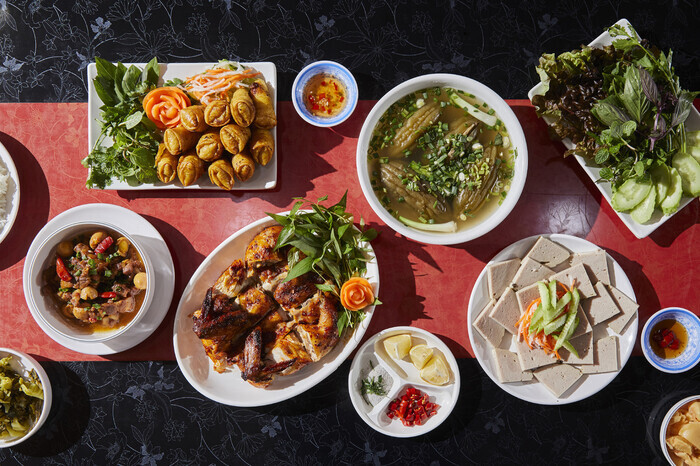
When I opened the door, an electronic carol played, the kind of tune that plays on a loop when a truck goes into reverse. There were no customers dining at the restaurant, though it had the capacity to seat a hundred.
Behind the counter stood a slender man with graying hair. An exotic smell penetrated my mask. It was the aroma of fish sauce that one only finds in an authentic Vietnamese restaurant, not ones tailored to American tastes.
With the carol and the aroma filling the air, the man began to speak. Im Hyeong-seop was the owner of the restaurant, called Dieu Hien Quan. I met Im while I was exploring restaurants serving global cuisine along the Multicultural Food Street in Ansan, Gyeonggi Province, for the new year.
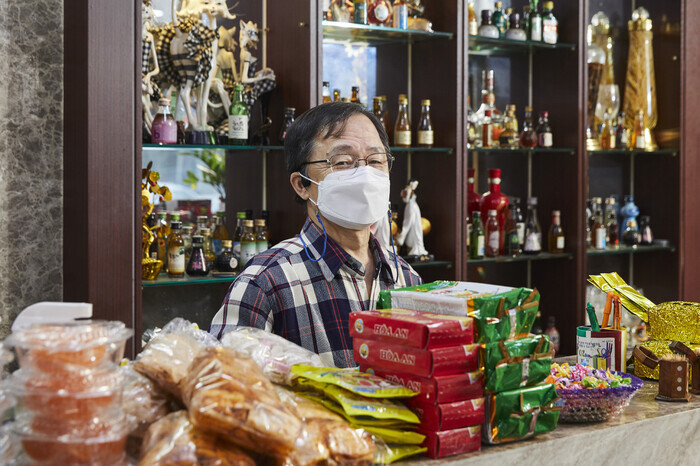
Ansan is the location of Korea’s biggest multicultural commercial district. More than 50 restaurants are registered with the Ansan Foreign Residents Support Center. According to statistics for November provided by the city of Ansan, the Wongok neighborhood where the Multicultural Food Street is located is home to 14,038 non-Koreans, around 70% of the total population of 20,100.
But those figures aren’t quite sufficient to convey what Ansan’s Multicultural Food Street feels like on the ground.
Beyond the resident population, the scale of Ansan’s multicultural district is further borne out by its foot traffic. Much like Koreans overseas who visit Koreatowns, the Multicultural Food Street in Ansan is a destination for foreign residents of Korea.
According to Tmoney transportation data, some 390,000 passengers disembarked at Ansan Station on the Ansan Line in November 2019, just before the COVID-19 pandemic erupted. Those sorts of numbers are one of the reasons Dieu Hien Quan has been able to operate at such a large scale, with a capacity of about a hundred.
But as of last month, the number of passengers disembarking at Ansan Station was around 300,000 — a decline of roughly 30%.
Dieu Hien Quan first opened its doors in 2005; Im is its fourth proprietor, having acquired the restaurant in 2014. The first owner was Vietnamese, and ownership has changed hands a few times over the years.
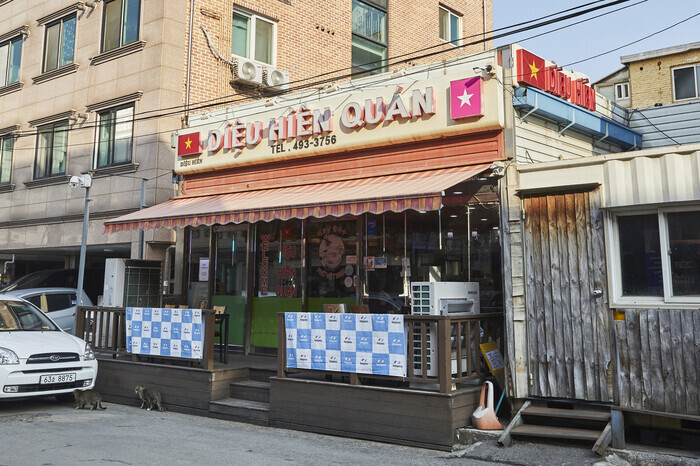
Im’s reasons for acquiring the restaurant were twofold. One factor was his retirement, the other his family. When he retired in 2014, his wife told him the restaurant was up for sale, and he made the decision to take over.
“I told them not to tailor it to Korean tastes,” he recalled. Indeed, the ownership is the only thing that has changed.
For that reason, the pho served at Dieu Hien Quan may seem unfamiliar to those who’ve only had the dish in Korean cities. Cilantro and vegetables are added stems and all; the broth blends the clear flavor of meat with savory spices. It’s the kind of distinctively Vietnamese flavor that anyone who has visited the country will recognize.
I deliberately picked a time when there would be few people at the restaurant. Even so, I could see two Vietnamese women picking and eating the leaves off the vegetables like a salad.
“I come here a lot because it’s similar to the way it tastes back home,” explained Lee Su-a, one of the women I encountered there. They had both come to Korea through marriage, they explained.
Indeed, marriage is one of the main reasons people from across the world come to settle in Korea. Owner Im Hyeong-seop himself acquired Dieu Hien Quan in part because of his wife, who is Vietnamese.
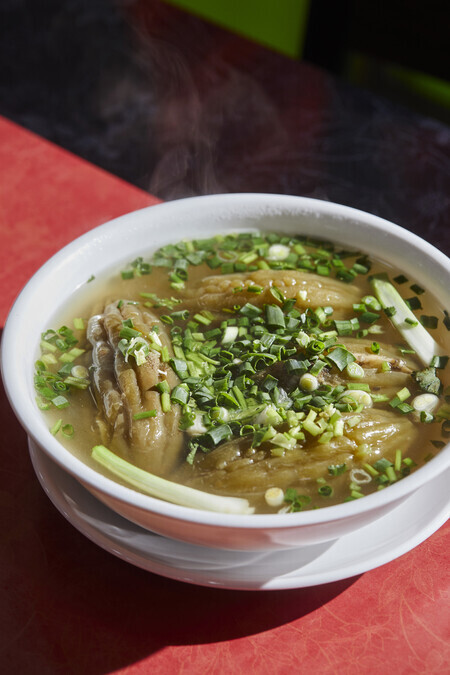
In addition to marriage, another big reason immigrants come to settle in Korea is because of work. Every weekend, migrant workers visit the restaurant to dine and pick up ingredients. This explains the showcase off to one side where Dieu Hien Quan sells Vietnamese groceries.
It’s a common sight in Ansan. Kusinang Pinoy, the Philippine restaurant that I visited for a story, had a supermarket section off to one side as well. The Indonesian restaurant Batavia likewise ran the second floor of its building as a supermarket, while operating a sit-down restaurant on the third floor.
When I asked for a typical Vietnamese Lunar New Year’s meal, the Vietnamese chef cooked up a whole table of food. One of the dishes was Vietnamese sausage sliced up into strips and garnished to be eaten with fresh vegetables. There was also the kind of fried food commonly seen in Vietnamese restaurants, along with a dish similar to Korean jangjorim, consisting of pork and quail eggs braised soy-flavored sauce.
The chicken looked like the sort of dish you would eat on a special occasion, grilled up with a pepper glaze. There was a pickled vegetable dish too, along the same lines as Korean kimchi or Western pickled cucumbers.
On the whole, the dishes were not much different from the sorts of things that would appeal to Korean palates. The soup has a particularly unique flavor, with what appeared to be Vietnamese cucumbers added.
I was on board with the idea of cucumber soup, and the boiled cucumbers had a nice texture, although the smell was unfamiliar. It may be exactly these elements that seem so peculiar to Koreans that the Vietnamese customers most long for.
The dishes I’m describing here aren’t actually on the menu, but I was told they are available on request.
If you were to simply walk into the restaurant, you would have no way of knowing the owner is Korean. The customers, the servers and the cook are all Vietnamese.
They may all have hailed from Vietnam, but they have their own individual stories. The cook is not yet able to communicate much in Korean. The part-time server comes from a well-off family back home and is currently studying for a master’s in business at a Korean university. Different people come to Ansan for different reasons, united over steaming hot bowls of pho.
One defining quality of Ansan’s multicultural district is that it brings together people from many different countries rather than just one.
Dieu Hien Quan is located in a kind of Vietnamese corner that has two other Vietnamese restaurants. But the owner of Kedai Rinjani, an Indonesian place that declined to take part in this piece, explained, “There are around 10 different Indonesian restaurants in Ansan, but they aren’t close to each other.” There appear to be various different factors at play that Koreans have no way of knowing about.
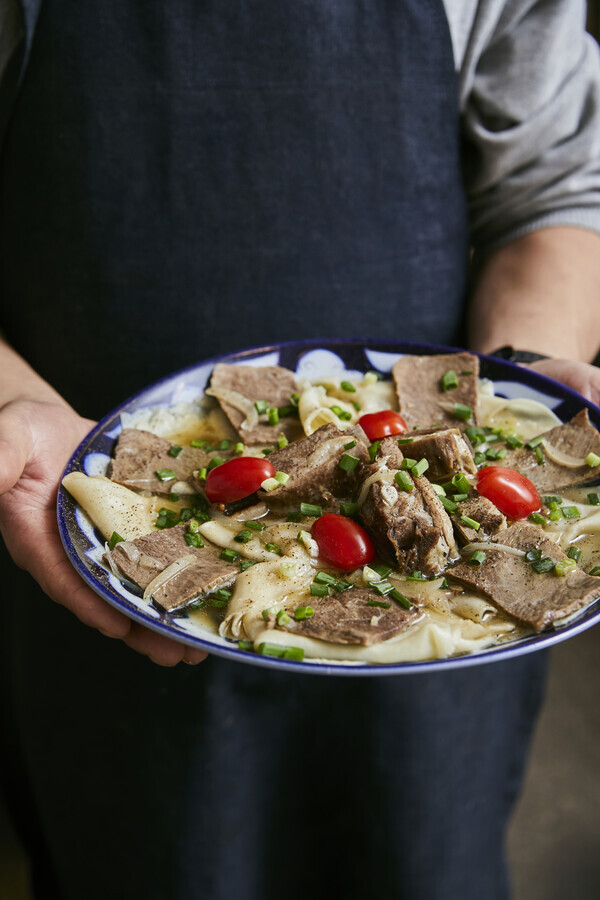
Residents all have different ways of ringing in the New Year too. For instance, Thai and Cambodian restaurants don’t celebrate New Year’s on Jan. 1. As Buddhist countries, they don’t have any special events for New Year’s Day by the solar calendar.
Kusinang Pinoy, the Philippine restaurant, had a Christmas party ahead of time rather than a Jan. 1 celebration.
Russia is one country that prepares a feast for New Year’s Day. To get a taste of such cuisine, you have to head to Ttaetgol, a Kareisky village that is a little bit afield from the main Multicultural Food Street.
My destination for a Russian New Year’s meal was called Avenue. Avenue used to be known as Victoria, but changed its name when its ownership changed hands.
Avenue’s distinction can be found in the Kareisky dishes on its menu. The term “Kareisky” refers to ethnic Koreans who live in Russia and other members of the Commonwealth of Independent States; in Korean these people are referred to as “Goryeo-in” or “Goryeo saram.”
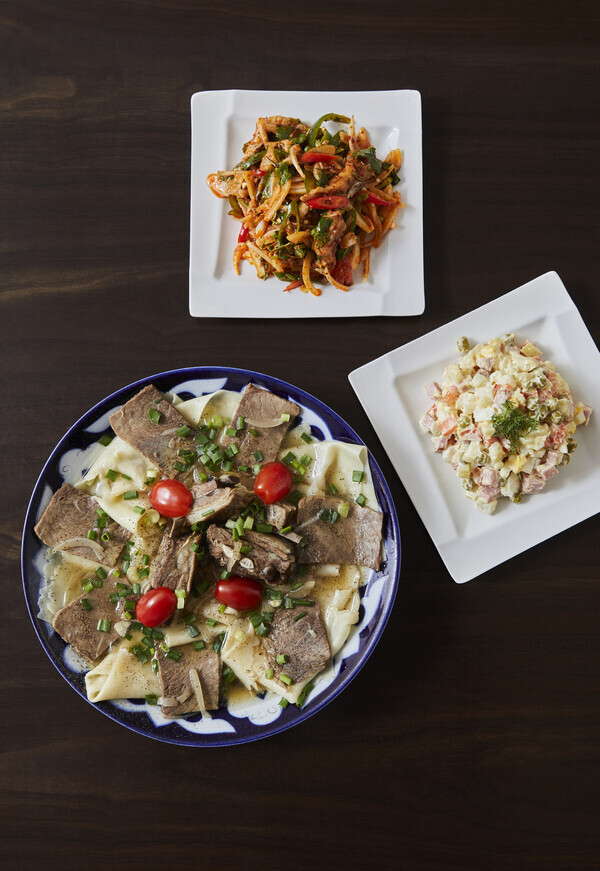
Anatoly, the owner of Avenue, is himself Kareisky. A native of Kazakhstan, he worked for a Korean company making construction sandwich panels for six years before he took over the restaurant’s ownership. Variations of his story can be seen in the lives of other overseas Koreans surviving abroad.
Anatoly prepared three dishes that Kareisky enjoy on New Year’s: salad, noodles, and Kareisky-style raw fish salad.
The salad used ham, boiled egg, carrots, potato, peas, and pickles mixed together with mayonnaise and black pepper. I could anticipate the flavor, although it seemed quite rich in calories for a salad. I wondered if this sort of richness was commonplace in countries with wintery climates.
The Kareisky-style raw fish salad left a particularly strong impression. While it didn’t look much different from its Korean counterpart of hoemuchim, the flavor was closer to a European ceviche. It had white fish mixed with bell peppers, red and green chilis, scallions, and onions, all mixed with red pepper oil and cilantro.
It seemed somehow touching to imagine Koreans recreating the flavors of their homeland like this on the other side of the Eurasian continent.
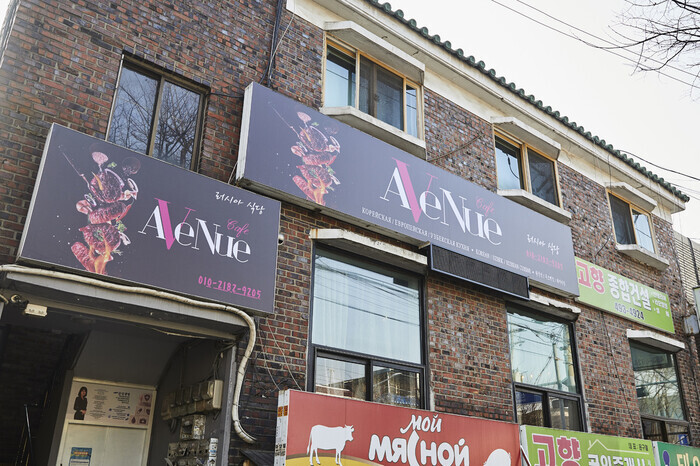
Whenever I’m covering a restaurant, I typically visit the neighborhood to ask people why they settled there, their goals for the future, and what have you. I asked Anatoly the same questions, and his face took on a quizzical expression, as if he wondered why I was asking such things.
For residents here, restaurants aren’t places for luxury consumption — which is not to say that the food isn’t delicious — but part of their lives.
“I hope COVID-19 ends soon. Before, we’d have 50 customers; now it’s 20,” he said.
“I have to make money. Our third was born nine months ago. I need the money.”
Anatoly spoke with a mixture of formal and familiar registers of Korean, a language he said he never knew before coming to Korea.
Kim Jeong-hwan, a 38-year-old who runs a furniture factory in Ansan, said, “Itaewon [a neighborhood in Seoul] is somewhere people from countries that are wealthier than South Korea visit; they don’t refer to that as ‘multicultural.’ Ansan has a ‘Multicultural Street,’ where there are people living here from countries that are worse off than Korea.”
“So the term ‘multicultural’ itself has a discriminatory element to it,” he explained.
Indeed, “multicultural” holds a kind of proper noun identity here. While I was speaking to Filipinos for the story, some of them would answer in English, but use Korean for the word “damunhwa” — meaning “multicultural.”
The so-called multicultural district in Ansan is a cosmopolis that remains unseen by Koreans. Even in today’s era where everything seems scored by reviews, it’s tough to find any Korean-language search results or reviews for Ansan’s plethora of diverse restaurants.
The people who frequent this street are workers from throughout the Korean Peninsula who come in search of the flavors and ingredients of their home countries. They’ve already established themselves as an indispensable workforce in Korea, but they are invisible people to city residents. The neighborhood truly is a prism in and of itself, reflecting the current state of Korean society.
While Koreans still hold many of the same preconceptions about foreign residents such as refugees and migrant workers, more and more of them are said to be paying visits to Ansan’s multicultural district.
Dieu Hien Quan has been visited by many Koreans who’ve never been to Vietnam. They come in search of authentic overseas flavor at a time when overseas travel is not an option. Avenue is similarly being visited more and more by Koreans looking to experience a taste of Russian cuisine.
Rather than spouting empty slogans about a “globalized society” and “diversity,” more Koreans should try visiting Ansan’s cosmopolis for themselves. On this one road, 21st-century Korea comes together with the world that exists inside of it.
By Park Chan-yong, columnist
Please direct questions or comments to [english@hani.co.kr]

Editorial・opinion
![[Editorial] Yoon must halt procurement of SM-3 interceptor missiles [Editorial] Yoon must halt procurement of SM-3 interceptor missiles](https://flexible.img.hani.co.kr/flexible/normal/500/300/imgdb/child/2024/0501/17145495551605_1717145495195344.jpg) [Editorial] Yoon must halt procurement of SM-3 interceptor missiles
[Editorial] Yoon must halt procurement of SM-3 interceptor missiles![[Guest essay] Maybe Korea’s rapid population decline is an opportunity, not a crisis [Guest essay] Maybe Korea’s rapid population decline is an opportunity, not a crisis](https://flexible.img.hani.co.kr/flexible/normal/500/300/imgdb/original/2024/0430/9417144634983596.jpg) [Guest essay] Maybe Korea’s rapid population decline is an opportunity, not a crisis
[Guest essay] Maybe Korea’s rapid population decline is an opportunity, not a crisis- [Column] Can Yoon steer diplomacy with Russia, China back on track?
- [Column] Season 2 of special prosecutor probe may be coming to Korea soon
- [Column] Park Geun-hye déjà vu in Yoon Suk-yeol
- [Editorial] New weight of N. Korea’s nuclear threats makes dialogue all the more urgent
- [Guest essay] The real reason Korea’s new right wants to dub Rhee a founding father
- [Column] ‘Choson’: Is it time we start referring to N. Korea in its own terms?
- [Editorial] Japan’s rewriting of history with Korea has gone too far
- [Column] The president’s questionable capacity for dialogue
Most viewed articles
- 1Months and months of overdue wages are pushing migrant workers in Korea into debt
- 2Trump asks why US would defend Korea, hints at hiking Seoul’s defense cost burden
- 3At heart of West’s handwringing over Chinese ‘overcapacity,’ a battle to lead key future industries
- 4[Editorial] Yoon must halt procurement of SM-3 interceptor missiles
- 5Fruitless Yoon-Lee summit inflames partisan tensions in Korea
- 61 in 3 S. Korean security experts support nuclear armament, CSIS finds
- 7Dermatology, plastic surgery drove record medical tourism to Korea in 2023
- 8AI is catching up with humans at a ‘shocking’ rate
- 9First meeting between Yoon, Lee in 2 years ends without compromise or agreement
- 10Amnesty notes ‘erosion’ of freedom of expression in Korea in annual human rights report